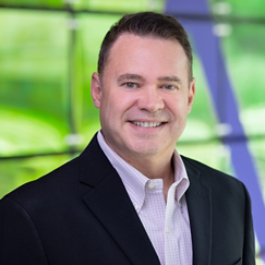
Our EnvironmentVideo
Helping Turn Climate Conversations Toward Climate Action
November 09, 2022
We’re sharing our strategy for reducing Scope 3 product-related emissions because others are ready to follow our lead.

Our EnvironmentVideo
November 09, 2022
We’re sharing our strategy for reducing Scope 3 product-related emissions because others are ready to follow our lead.
In the face of unprecedented climate change, more and more people, corporations, NGOs and policy makers are sensing the urgent need to decarbonize.
We’ve been talking about—and making strides toward—reducing our impact on the built environment and cold chain for more than a decade. When we first started on our own journey there were only a few other organizations on this path with us. I’m pleased to report that we are no longer one among a few. With each chance I get to share our story at climate events and conversations, like the Sustainable Innovation Forum at COP27, the audience size has grown exponentially, and rooms are packed with people fervently dedicated to reducing their organizations’ impact on our climate.
I’m most often asked how we got started. For us, it began with identifying the place that our business had the most opportunity to bend the curve on emissions and setting bold corresponding commitments. The built environment is a major contributor to global
carbon emissions, representing 39% of global carbon emissions annually. Of that figure, 28% of carbon emissions come from the energy needed to heat, cool and power them. This is where Trane Technologies can make a great impact. Scope 3 emissions make up more than 93% of our carbon footprint and include the carbon emitted by the products we make while in use and at the end of the lifecycle. That large opportunity forms the foundation of our Gigaton Commitment – our science-based plan to reduce our customers’ carbon emissions by one billion metric tons by 2030.
Identifying the most significant decarbonization opportunities for your business is the first step, and depending on the sector your business serves, the categories of scope 3 emissions will differ.
What I can share from our experience, is that when you calculate the entire emissions footprint of your value chain, some revelations occur.

Common accounting frameworks and criteria, like the Science Based Targets initiative, now exist to help to establish, track, and disclose company-wide emissions and progress within your footprint. Putting these frameworks into action puts you on the path. Then being regularly transparent about progress demonstrates integrity and trust in your plan.
This is what we address and share in our Gigaton Challenge Playbook. We outline the biggest levers we have to decarbonize our customers’ business – and the science-based method we are using to calculate product-related CO2e reductions from a 2019 baseline.
Sharing our playbook is how we are holding ourselves accountable toward these ambitious goals. It’s also to help others who are on earlier stages of their climate journey to carve a path of their own. So, while the rooms are packed and companies are moving from lofty commitments to all-in action, we are helping accelerate the momentum of action by providing our insight into how to get there.
Addressing climate change is a monumental journey we are all on together, and it’s exciting to be at the forefront. It’s even more exciting to see who is coming along with us.
Scott Tew: Yeah. I think the most exciting thing is just the energy. I mean, the rooms are full of people who want to know what's it take to, to get started, to, to make things happen? I, I remember years ago when the rooms were not packed and people were thinking that company commitments were just words on paper. That's not where we are today. I mean, companies of all sizes, small, medium, large, uh, they're all at the table, they're all trying to figure out what their plan forward is. I’m excited most because so many are doing so much, and there's this eagerness to learn from others. I mean, we've all talked about best practice learning for years and we all know what that is. I've never sensed a, a moment before where so many companies are willing to share what's working and so many companies are taking what they're hearing back inside their own companies to make progress.
For Trane Technologies, it was about recognizing the big opportunity, 15% of the world's greenhouse gas emissions related to heating and cooling buildings, and so, you can look at that as a big opportunity or, or a big problem. We chose opportunity and, you know, I ... As I explain how we got started, it was that recognition and then setting a bold commitment, our Gigaton Challenge, sort of was the launching pad for all our actions since.
We get a lot of questions about science-based targets, outside groups that can validate whether your commitments are big enough, and, you know, we certainly endorse using science, having commitments and your data reviewed by outside parties. The SBT groups, science-based targets group, is a way to get started. But beyond that, we invite other companies to join us in this transparency movement - around showing your data, talking about what's working, where you're having problems. I think we're setting a good example for how to do that with our website and reports that we're disclosing our progress in and other companies are very interested in how they get started in that journey, too.
Part of our work to be more transparent around our progress has involved us putting together and developing a Gigaton playbook, and the playbook is really that – it’s to help people who want to know more about how you calculate Scope 3 emissions reductions, what specifically is Trane Technologies doing, what's in our calculations. You know, we have everything from the specifics of a system which includes refrigerants, energy, efficiency and, and other important factors.
But no matter what company is getting started here, there's a playbook they probably should develop as well to help those interested parties. Customers, investors, their own employees understand what it takes to make progress against the commitment.
Recommended for you
Our Environment Article
The Power of PartnershipOctober 25, 2024
We amplify our impact on issues from global climate action to local community needs through our partnerships.
This article is co-authored by Deidra Parrish Williams, Global Corporate Citizenship Leader, Trane Technologies.
Our Environment Article
Trane Technologies Tackles Embodied Carbon at UNGA Goals HouseOctober 14, 2024
Trane Technologies VP of Sustainability Scott Tew discusses the company’s move to reduce embodied carbon at UNGA Goals House at Climate Week NYC 2024.
Our Environment Article
Leading on Embodied CarbonSeptember 23, 2024
Trane Technologies’ sustainability and procurement leaders on the company’s move to reduce embodied carbon by 40%.
This article is co-authored by Kinnar Ghiya, Vice President, Procurement, Trane Technologies.
Our Environment Article
Building a MovementJune 17, 2024
The technology exists today to decarbonize the built environment. How will we get to net-zero? Together.